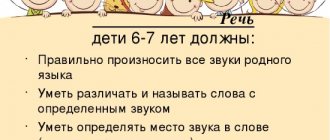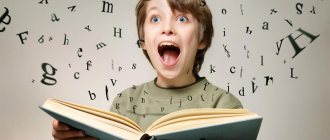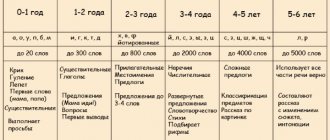Causes of speech defects
There are quite a few of these factors. They can be either hereditary or acquired.
The causes of speech defects include:
- negative effects on the fetus during pregnancy and childbirth (for example, hypoxia - oxygen starvation);
- heredity;
- birth injuries to the head or brain damage in children under 3 years of age;
- structural features of the speech apparatus (for example, a short hyoid frenulum);
- lack of communication;
- mental trauma, tense family situation;
- an example of incorrect pronunciation on the part of adults.
SPEECH DEFECTS IN CHILDREN
It is believed that the peak activity of a child’s speech development occurs at 2.5-5 years. A normally developed child at the age of three should already be able to express himself in coherent sentences. A child should speak at least 5-10 words per year; by 4 years, the vocabulary should be at the level of 1000 words.
Up to 3 years of age, burr and lisp are not considered a speech defect and are explained by insufficient development of the articulatory apparatus (the tongue is most often located between the teeth when speaking). To eliminate these phenomena, parents are advised to carefully, unobtrusively correct errors in pronunciation, regularly pronounce words with errors, or work on individual sounds. If he hasn’t spoken before the age of three, he should be urgently shown to a specialist. Moreover, most likely, you will need the help of not only a defectologist, but also a neurologist.
We have already said that for proper speech development, adults must speak to the child clearly and intelligibly. Mangling words should not be encouraged, since over time such incorrect pronunciation will become a habit.
What are the types of speech defects?
There are defects in written and oral speech. In addition to their origin and impact on child development, they also differ in severity.
Dyslalia or tongue-tiedness
Dyslalia is the incorrect pronunciation of sounds or their replacement with other sounds.
This defect is quite common in preschool age. The child may burr or lisp.
Such a deviation means that the baby has good hearing, but a poorly developed articulatory apparatus. That is, with systematic training of the muscles of the tongue, cheeks and lips, you can learn correct pronunciation.
Dysarthria
Dysarthria occurs due to inadequate functioning of the nervous system and speech organs.
Children with dysarthria have impaired mobility of the lips, tongue and palate. It is difficult for such children to pronounce words and phrases.
Most often, dysarthria entails a general underdevelopment of speech.
Rhinolalia
In children with this speech defect, the function of the nasopharynx is impaired. Because of this, the pronunciation becomes nasal, as if with a severe runny nose.
Stuttering or logoneurosis
When a child stutters, he repeats the same syllables and words several times.
This occurs due to excessive tension in the muscles of the speech apparatus and improper breathing.
Often the problem lies in psychological reasons (for example, fear, excessive chronic fatigue, rapid development of vocabulary, etc.). In these cases, the defect is associated with logoneurosis.
Typically, stuttering occurs between 2 and 5 years of age, when children (usually boys) are actively learning to speak.
Alalia
Alalia is a severe underdevelopment of speech or its complete absence.
This pathology usually occurs in connection with birth injuries.
Despite normal hearing and mental development, such children have damage to those parts of the brain that are responsible for speech development.
With motor alalia, the child understands what is said, but cannot reproduce it.
With sensory alalia, the baby cannot understand someone else's speech.
You can work with some speech defects in children yourself
Tahilalia
This defect is manifested by an accelerated rate of speech. Children with tachylalia speak approximately 2 times faster than children with normal speech development. In this case, kids can repeat syllables or, conversely, skip them.
Bradylalia
This disorder is characterized by a slow rate of speech due to the fact that it is difficult for the child to make some articulate sounds.
Dysgraphia and dyslexia
Often these disorders occur together.
Children with dysgraphia They do not understand the sound composition of the word and therefore write with errors.
Dyslexia is the inability (or difficulty learning) to read.
With this type of disorder, children's intelligence is normal, but the areas of the brain responsible for reading functions do not work well enough.
Aphonia and dysphonia
Dysphonia is a partial loss of voice, and aphonia is a complete loss.
With this defect, the child cannot speak at all or speaks only in a whisper. Such disorders arise both for physiological reasons (for example, due to disruption of the laryngeal nerve) and psychological reasons (due to excessive anxiety, etc.).
Speech disorders
Speech disorders in childhood are a wide range of disorders that differ in the mechanism of formation, structure and method of overcoming them.
Causes
Speech disorders in childhood can be a consequence of intrauterine injuries in a child (alalia, rhinolalia), birth injuries (alalia, dysarthria), a consequence of diseases that interfere with the normal mental (autism) and physical (cerebral palsy, polyarthritis) development of the child, a consequence of injuries and harmful influences on the child’s nervous system, obtained at a time when speech was already developed (aphasia).
Speech disorders can be a consequence of damage or immaturity of various organs or parts of the brain (cleft palate with rhinolalia; functional immaturity of some parts of the cerebral cortex with alalia; subcortical disorders with dysarthria; as well as motor and emotional disorders; hearing loss). Also, speech disorders can be a consequence of incorrect learning (for example, incorrect sound pronunciation in dyslalia), a consequence of bilingualism, social deprivation or pedagogical neglect.
The leading role in the structure of a particular speech disorder can be played by: impaired understanding of spoken speech (sensory alalia, hearing loss), impaired innervation of the speech apparatus (dysarthria), an anatomical defect in the peripheral part of the speech analyzer (rhinolalia), immaturity of the motor sphere (motor alalia).
Speech disorders can act as independent developmental disorders or be combined with delays and disturbances in the development of the motor, intellectual, emotional and behavioral spheres.
Thus, the clinical picture of speech disorders in childhood is varied and unique in each individual case. To effectively overcome speech disorders, accurate diagnosis and qualification of speech disorders is necessary. Diagnosis of speech disorders and speech diagnosis is carried out by such specialists as a speech therapist and a neuropsychologist. In view of the fact that speech disorders are often associated with disorders of a deeper level, an important step in examining a child with speech disorders is an examination by a neurologist and functional diagnostics (EEG, ultrasound, evoked potentials).
An additional difficulty in working with speech disorders is the lack of a unified classification of speech disorders. In Russia, it is customary to use two classifications of speech disorders.
Classification
Clinical and pedagogical classification includes two sections:
Oral speech disorders: dyslalia, rhinolalia, dysarthria, stuttering, alalia, aphasia; Written speech disorders: dysgraphia, dyslexia. This classification divides speech disorders according to the structure of the disorder. The psychological and pedagogical classification also includes two sections:
Violation of means of communication: phonetic-phonemic underdevelopment of speech (FFSD), general underdevelopment of speech (GSD); Impaired use of communication tools: stuttering. This classification was created during the USSR and was used to complete children's groups. The use of this classification does not provide an understanding of the structure of the disorders, but rather describes the external manifestation of the disorders and severity (ONR levels I-II-III). Using the term FFND, one can describe disorders as diverse as dyslalia, rhinolalia, and dysarthria, while ONR can imply sensory or motor alalia. Often, confusion with speech diagnoses is enhanced by the use by specialists of such definitions as mental development delay (MDD), speech development delay (SSD) and psychospeech delay (PSRD). These terms arose in the works of researchers (teachers, speech therapists and psychologists) and are conditional and, to a high degree, generalizing concepts. These terms do not describe the structure of the disorders, and in the conclusions of neurologists they are used as an addition to the clinical diagnosis.
Another speech diagnosis in childhood that can confuse parents and some specialists is dysphasia. Dysphasia is often understood as a delay in the development of speech as a higher mental function due to the functional immaturity of the cerebral cortex. We can say that dysphasia is a synonym for alalia.
Treatment
Overcoming speech disorders in childhood is carried out by specialists from the department of therapeutic pedagogy: a speech therapist and a neuropsychologist, as well as medical specialists, primarily a neurologist. In some cases, consultations with doctors of related specialties are required: psychiatrist, cardiologist, immunologist, pediatrician.
The selection of specialists in each individual case occurs individually. Often, in mild cases of dyslalia, a few meetings with a speech therapist are sufficient, while in case of alalia or aphasia, a comprehensive systematic approach is required, including observation by a neurologist, joint work of a speech therapist and a neuropsychologist, periodically repeated courses of massage, osteopathic treatment and a rehabilitation course of transcranial magnetic stimulation ( TMS).
When is it time to sound the alarm?
By the age of 1 year, the baby should be able to pronounce from 5 to 10 words. If he talks less or doesn't talk at all, that's a red flag.
At 2 years old, children already communicate in simple phrases, use verbs, and their vocabulary is about 200-300 words.
At 3 years old, a child actively uses common phrases - for example: “Masha (has) a Dasha doll.”
It is worth consulting with a speech therapist if the baby still speaks in monosyllabic sentences. You should also contact a specialist if your baby pronounces sounds incorrectly. Another cause for concern is the absence of verbs in speech, the pronoun “I” and the incorrect order and forms of words in sentences.
At the age of 4, children pronounce the sounds Z and S well. They already know how to talk about events that have happened, ask questions and express their thoughts out loud. The children also use words in their speech that denote temporal and spatial concepts (close, far, soon, etc.)
Five-year-old children can pronounce the hissing words Ш, Ж, Ш. They use all parts of speech in sentences and use generalizing words (car, plane is transport, etc.). The children are able to pronounce words without omissions or substitutions of syllables and sounds.
At the age of 6, a child should learn to pronounce the letter P and speak fairly long phrases without mistakes. Children 6-7 years old can correctly use sayings, set expressions, and also explain the meaning of words.
If you have the slightest doubt about speech development, you should contact a speech therapist. The sooner you start acting, the faster you can correct the defect.
Work on the correction and development of speech in children with general speech impairment (GSD) is labor-intensive and painstaking work, designed to last more than one year and affecting all aspects of speech. To achieve the best results, it is necessary that all participants in this fascinating process: a speech therapist, a neuropsychologist, a child and his parents form a strong union of like-minded people, the main task of which is the formation of speech-thinking activity, competent speech of a beloved child, as a ticket to life in the big world of adults.
Like any process, speech formation occurs gradually, step by step, from simple to complex. In parallel, working on the formation of all language levels: sound, verbal and word-formation, grammatical and syntactic.
In order to express his thoughts most correctly, completely and accurately, a child must have a sufficient vocabulary. Therefore, work on the correction and development of oral speech begins with expanding and improving the vocabulary. In this case, the word is considered as a lexical unit of the language and as a grammatical and syntactic unit of a sentence. By introducing children to the concepts of “a word denoting an object” and “a word denoting an action of an object,” they thereby prepare a platform for working on a sentence. By giving the concept of “a word denoting a characteristic of an object,” material is accumulated for spreading the sentence by definition.
After children have formed an idea of the words denoting an object and the action of an object, children are brought to the concept of a sentence and begin to work on the structure and grammatical design of the sentence.
After children learn to compose a common sentence and form it grammatically correctly, they move on to working on coherent speech.
First, we teach children to retell short stories based on the sequence of actions occurring in the story. then move on to descriptive stories. After which they move on to teaching children short, selective and creative retelling.
Having taught children retelling, they move on to developing in children the skill of composing short stories based on a series of pictures, a plot picture and a series of subject pictures.
Work on the syllabic composition of a word precedes work on the sound-letter composition of the word. By dividing words into syllables, children learn to recognize and isolate vowel sounds, which are the sound basis of a word. This is important considering that omitting vowels in words is one of the most common mistakes children make when writing.
After children learn to isolate vowel sounds from a word, they move on to work on isolating consonant sounds. First, children are taught to hear and distinguish between hard and soft consonants.
Work on the sound-letter composition of the word has actually already begun in the early stages. By this time, children already have an idea that words consist of sounds (letters); they are able to isolate vowel sounds from words, hear the presence of hard and soft consonant sounds in words, and identify the letters that indicate these sounds in a word. By completing tasks, children learn to listen and read words, to feel each subsequent sound in a word. Work on children’s assimilation of the sound-letter composition of words is carried out using the material of monosyllabic words. As practice shows, if a child learns to correctly perform sound-letter analysis of a monosyllabic word, then he can easily analyze and correctly write words of any syllabic structure, even the most complex.
At the same time, from the very first stage to the last, work is underway on sound production, automation of practiced sounds and their introduction into spontaneous speech.
Article by children's speech therapist Natalia Tsvetkova.
How to correct speech defects in children
Usually, at the age of 1.5 years, children are recommended to visit a speech therapist. The specialist will determine whether speech development is normal. If necessary, he will recommend a set of exercises to correct disorders.
You need to follow the specialist’s recommendations every day, but without “pressing” the baby. Classes should be fun. To do this, for example, you can do speech therapy exercises together with toys.
Speech pathologist or speech therapist?
A speech therapist corrects mild speech disorders, such as tongue-tiedness and logoneurosis. It also helps to correctly pronounce sounds and improve speech breathing.
A child needs a speech pathologist when speech impairments are pronounced, such as alalia or dysarthria. With such defects, there are problems not only in the speech apparatus, but also in nerve impulses, sensory perception, etc.
Children with complex defects, in addition to impaired speech, suffer from unstable attention, poor memory and emotional deviations. A defectologist will help solve the development problem in a comprehensive manner.
How parents can work with their child’s speech defects
What parents can do
- It is necessary to promptly (at the first signs of speech impairment) seek advice from a speech therapist.
- It is important to strictly follow the specialist’s requirements and do the exercises he recommends every day.
- From a very early age, you need to actively talk with your baby - describe to him your actions, objects around, etc.
- It is important to encourage your child to talk. Perhaps you shouldn’t immediately “understand” what the baby wants - so that he has an incentive to “reach out” to the “unintelligible” mother, explaining in a word or phrase what he wants.
- Joint singing, reading aloud, finger games and speech therapy gymnastics are of great benefit.
- It is useful to develop articulation muscles in front of a mirror - for example, sticking out your tongue or swinging it from side to side.
- Parents should set the right example - speak slowly, pronouncing all sounds clearly.
- There is no need to be overzealous with early development - this can overload the baby’s fragile psyche.
- Head injuries must be avoided.
- You should never put pressure on your child, persuading him to study.
- There is no need to blame for failures.
- It is important to praise your child for the slightest achievements during classes.
Exercises to eliminate speech defects in children
There are simple speech therapy exercises that you can do with your child at home on your own.
Certain exercises are suitable for solving a specific speech problem.
They can be aimed at:
- formation of correct speech breathing (for example, breathing exercises);
- development of the muscles of the articulatory apparatus (articulatory gymnastics);
- practicing sounds that are difficult to pronounce (such as Z, S, R, L, Zh, Sh, Shch).
By systematically performing sets of speech therapy exercises, from simple to complex tasks, you can achieve tangible results and eliminate speech disorders in a child.
Speech defects are a fairly common childhood problem. The reason for this is birth trauma, heredity, and the bad example of others. It is necessary to monitor the development of the baby’s speech and promptly seek help from specialists - a speech therapist or speech pathologist.
It is important to start working with speech impediments as early as possible. With daily systematic work, you can achieve a tangible effect.
Below is a table from which you can understand whether the baby’s speech development corresponds to the norm.
Correction methods
Delayed speech development and alalia in a child are complex problems, so correction of these conditions requires a systematic approach to treatment, during which the child not only acquires speech, but also develops as a person. In the approach to correction, the speech therapist requires a well-thought-out methodology and a step-by-step structure of work with children.
At the initial stage of correctional classes, the speech therapist-defectologist:
- relies on the child’s intact functions, that is, the basic components of speech, vision, hearing, sensory development, as well as fine and gross motor skills identified during the diagnosis of neuropsychic development;
- balances the processes of excitation-inhibition, organizes activity (establishes contact and order in actions; plays games with him to retain and switch attention, to auditory-verbal attention);
- teaches the implementation of instructions or requests, since this is the basis for all subsequent correctional activities. More often this happens in a playful way, through training to play by the rules and involvement in story-based games.
- stimulates elementary imitative activity, leading the child from non-speech to speech activity (manual imitation, bodily imitation, asymmetrical imitation; imitation of oral actions; practicing 5-6 vowels; differentiation of consonants; repetition of syllables, etc.);
- teaches orientation in space and rhythmic activities (games with hoops, balls, tape, water, bells, etc.), and also works with fine motor skills (function of the hands and fingers).
- promotes the expansion of active and accumulation of passive vocabulary;
- at the end of the initial stage of work, he introduces work with a mirror and articulatory gymnastics (simple exercises).
After completing the formation of the psychophysiological basis of speech in a child, the speech therapist-defectologist moves on to the next stages of treatment, which includes the formation of phrasal speech and the complication of the dictionary. The child is taught to pronounce more common, grammatically structured sentences, conduct small dialogues and make descriptive stories.
At the end of correctional work with a speech therapist, non-speaking children learn more complex communicative activities and skills that form coherent speech.
Table of norms of speech skills by age
| Age | Speech skills, vocabulary |
| 1 year | 5-10 simple words denoting a loved one, object or action: mom, baba, bi-bi, give, bang, etc. |
| 2 years | 300-400 words, short sentences, use of verbs, adjectives. |
| 3 years | About 1500 words, use of the pronoun “I”, use of sentences of 3-4 words with the main parts of speech (verbs, adjectives, adverbs, etc.) |
| 4 years | 1500-2000 words, use of prepositions and conjunctions, temporal and spatial concepts. The softened pronunciation of consonants disappears. The child can pronounce hissing (Ш, Ш, etc.) and whistling (S) sounds. |
| 5 years | 2500-3000 words. The use of words is correct, without rearranging syllables and sounds. Using generalizing words (a skirt and a jacket are clothes, etc.) |
| 6-7 years | 3500 words. Figurative words and expressions are used (for example, “neither light nor dawn”), established phrases and sayings. A child can explain the meaning of a simple word and talk about its origin. |
If you liked the article, please share a link to it
Speech development disorder in a child
Speech is a necessary element of our life. From childhood, children learn to pronounce sounds and then words. If a child has learned to speak, then he can calmly communicate with his peers, make contact, play, and explore the world. The child will be happy to go to kindergarten or school.
IN
Unfortunately, there are children with speech development disorders. Such children become objects of ridicule from their peers, they withdraw into themselves. Studying is difficult for them, mainly due to the psychological factor. They become irritable and begin to lag behind their peers. To avoid getting into this situation, take care of your child’s speech development in advance. At the Epihelp clinic, experienced staff will conduct detailed diagnostics. Based on the results of the examination, treatment is prescribed.
Causes of speech impairment in children
Even during pregnancy, the expectant mother needs to monitor her diet and health. Monitor to ensure there are no intrauterine pathologies.
The child may be affected by:
- Hypoxia.
- Prematurity.
- Use of illegal drugs during pregnancy.
- Bad habits.
- Mom's stress.
- Birth injuries.
Psychological trauma and illness have a great influence on the development of speech.
Types of speech disorders in children
- Stuttering.
- Dysatria. Quiet voice, unclear pronunciation, impaired breathing. Speech can be either fast or slow.
- Alalia. Damage to the brain, resulting in speech being heard but not perceived.
- Dislalia. Difficult pronunciation of consonants.
If signs of speech impairment are detected, you must urgently contact a specialist. Conduct an examination, consult with a neurologist, psychologist and speech therapist.
IN
If a baby at 1 year old does not speak words or by 2 years old only speaks individual words and is very difficult to understand, then parents, and sometimes doctors, often believe that there is no reason to worry. In most cases, they prefer to wait, especially if the child is a boy.
In a number of children, speech development is only slightly delayed and by the age of 3-4 years it already levels out to the age norm. But for many children, waiting time is a missed opportunity to get timely help.
Determining the cause of delayed speech development at a fairly early stage is not easy, but it is very important. There are many different causes and types of speech development disorders. Methods of correction and treatment differ significantly in different cases. The variety of speech disorders is explained by the complexity and multi-stage nature of speech mechanisms.
Make an appointment with an experienced neurologist at the Epihelp clinic. You will receive a detailed answer and a detailed plan for further action. All this will affect the rapid development of your child’s speech.







